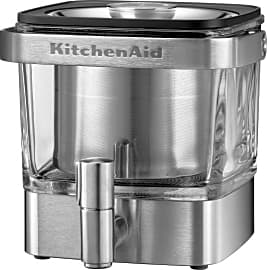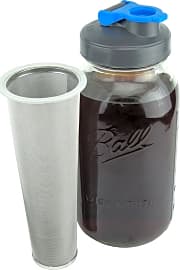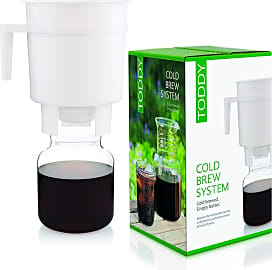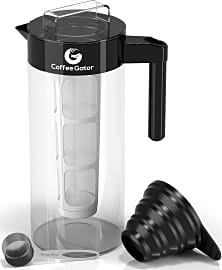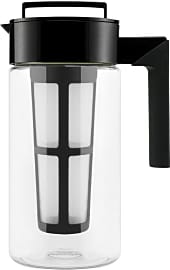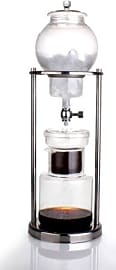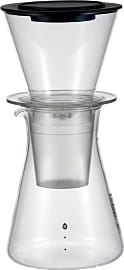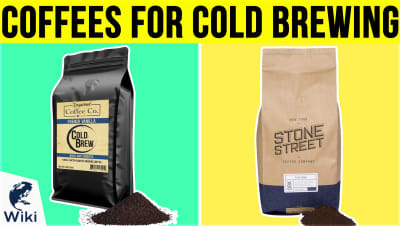The 10 Best Cold Brew Coffee Makers

This wiki has been updated 37 times since it was first published in July of 2015. If you are a java connoisseur who can handle a bit of a wait in return for a great tasting cup, then you may want to try one of these cold brew coffee makers. While they take much longer than traditional machines, they tend to produce a smoother result with a slightly sweet flavor and very low acidity. All you have to do is add water and your favorite ground beans, and be patient. When users buy our independently chosen editorial recommendations, we may earn commissions to help fund the Wiki.
Editor's Notes
June 23, 2020:
Fixing a cup of cold brewed coffee right at home each morning can end up saving you significant time and money, and each of these highly rated cold brew coffee makers can bring you a smooth, flavorful cup that rivals those of the fancy coffee shops. Some, like the Toddy System, are also well suited for steeping flavorful teas. Some even come with intriguing designs that are fun to watch, including both the Yama Glass Silverton and the Nispira Luxury, both of which resemble materials used during science experiments.
In this update, we added in the KitchenAid 28 Ounce, which is available from a highly respected name in products for food and beverage preparation. This model’s thoughtful, compact design ensures it will fit nicely on your countertop or in your fridge, and the built-in tap makes it easy to pour from, no matter where it’s situated. It boasts a comfortable carrying handle and a steeper that’s conveniently labeled with fill-level indicators. It’s equipped with simple illustrated instructions and a one-year manufacturer’s warranty. For a simple design that’s relatively inexpensive, we added in the County Line Kitchen Mason Jar, which features a sturdy soda-lime glass Ball jar with a generous two-quart capacity. It’s got a removable mesh filter and a sturdy silicone seal for freshness, as well as a handy flip-cap lid. Another new addition, the Coffee Gator Kit, features a somewhat common design, but this one is made of rugged borosilicate glass, instead of plastic. What also sets it apart is it comes with both a handy measuring scoop and a funnel that helps ensure mess-fee pouring of your grounds.
Leaving the list today is the Hario Mizudashi Pot, which features instructions that are written only in Japanese, and which also features a filter basket that’s small, compared to the other models, so the grounds aren’t steeping in as much of the liquid. Also making its departure is the Filtron Concentrate Brewer, which features a top-heavy design that’s prone to toppling.
Special Honors
Cold Brew Avenue Commercial Size 15 Gallon Designed with coffee shops and restaurants in mind, this large device makes it a cinch to fix large batches of cold brew coffee. Its features a stainless steel kettle and a custom-fit stainless steel filter plate. You can use it to brew anywhere from 15 to 40 gallons’ worth of ready-to-drink coffee or cold brew concentrate. The heavy-duty filter basket is designed for quick emptying of grounds when you’re done. The stainless steel components are more sanitary and durable than plastic ones. This system makes it easy to filter directly from the system into a keg, so you can serve delicious coffee on draft. coldbrewavenue.com
The American Coffee Culture
In the 1990s, American coffee culture exploded to new heights.
For some, a morning without a cup of freshly brewed coffee seems almost un-American. Coffeshops dominate the landscape in most metropolitan areas with many busy streets having two or three in close proximity to each other. It wasn't always like this though. Long before the days of Starbucks and specialty coffee blends, the average American was drinking bland cups of light coffee that came in a tin from the grocery store. Decaffeinated versions were even worse and most just avoided them.
In fact, coffee consumption was on a steady decline in America from the 1960s onward. In 1962, roughly 75% of adult Americans were drinking coffee and by 1988, it was down to 50%. Those who did drink coffee were drinking less too. The average consumer went from drinking three cups a day in the 1960s to two cups a day in 1980. At this same time, coffee retailers noticed that the new generation of adults in the 20 to 29 year old age bracket weren't drinking coffee. So what changed?
In a word... marketing. Kenneth Roman Jr., the president of one of the PR companies that worked with Maxwell House realized that young consumers didn't feel a connection to coffee and saw it as a drink for old people. He suggested Maxwell House place an emphasis on value, quality, and image by creating segmented products to appeal to specific groups. This was the beginning of specialty coffee. Soon flavored coffees were flooding the shelves, and specialty blends from specific regions of the world were available for the discerning consumer who would happily pay more for higher quality blends with unique flavors.
In the 1990s, American coffee culture exploded to new heights. Starbucks went from having just over 100 stores in 1991 to nearly 6,000 by the year 2000. Other specialty coffee stores like Coffee Bean and Tea Leaf, Caribou Coffee, and Peet's Coffee opened store after store across the nation.
Now most Americans stop by their favorite coffee shop multiple times a week to pick up anything from a double non-fat vente latte to an iced caramel frappuccino, all thanks to a tremendously successful coffee re-branding effort started by Maxwell House and Kenneth Roman, Jr.
Origin Of Cold Brew Coffee
Most of us traditionally think of coffee as a hot beverage, or at least brewed with hot water, but before the days of electricity, cold-brewing may have been the most common way of making it. The first concrete evidence of cold-brewing coffee comes from 17th century Japan, in the prefecture of Kyoto. It is speculated that the Japanese were first exposed to the cold-brewing method of making coffee by Dutch traders.
The first concrete evidence of cold-brewing coffee comes from 17th century Japan, in the prefecture of Kyoto.
Over time, the Kyoto style of cold-brewing became extremely artistic and instead of an immersion method in which the grounds are left sitting in water for hours, they began to slowly drip it through the coffee. They created graceful glass towers that made the brewing of coffee a thing of beauty to watch.
Cold-brewing is a time consuming method of making coffee and oftentimes the grounds may be steeped in water for up to 24 hours. This produces an extremely concentrated coffee, which is often diluted with water before being served. Cold brew is popular as it can highlight nuances in the coffee that can be lost to high temperatures. It is also a convenient way to have your morning coffee ready for you when you wake up. Instead of having to start the brew in the morning, it can be started before you go to bed and be ready and waiting for you to grab on your way out the door.
Tips For Cold Brewing Coffee
When making cold brew coffee, you always want to start with fresh beans, preferably ground just before brewing. Coffee oxidizes when it is exposed to oxygen and ground coffee oxidizes quicker than beans as it has more surface area and the oxygen can penetrate deeper into the cells. Using fresh roasted coffee beans that are freshly ground will ensure you end up with a coffee drink that is bold and flavorful. You can also try using a more acidic coffee than you might regularly drink when making traditional iced coffee. Cold brew coffee naturally comes out less acidic than hot brews. Because of this, you may find that you prefer drinking your cold brew with less cream and sugar as you normally add to your coffee.
It is also important to give yourself ample time as a standard cold brew takes a minimum of 12 hours.
It is also best to use some form of bottled or filtered water for cold brews. Using the water out of your faucet can impart unwanted flavors into the brew that can affect how your coffee tastes. Since cold brewing coffee allows you to taste every subtle nuance in the coffee, even just a hint of an unwanted taste can make a big difference.
After you add the water and coffee to your cold brewer, put it into the fridge while it steeps. This will keep the coffee cold the whole time and prevent any flavor loss. Make sure to cover it as well. Otherwise it can pick up unwanted smells or flavors from other foods inside your refrigerator. It is also important to give yourself ample time as a standard cold brew takes a minimum of 12 hours. If you can wait 24 hours, it is even better.


